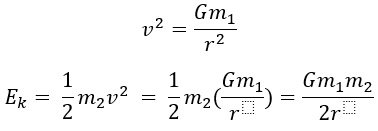Home » EasyPhys » Advanced Mechanics » Motion in Gravitational Fields » Derive quantitatively and apply the concepts of gravitational force and gravitational potential energy in radial gravitational fields to a variety of situations
Derive quantitatively and apply the concepts of gravitational force and gravitational potential energy in radial gravitational fields to a variety of situations
– The concept of escape velocity ?esc=√2???
- Escape Velocity: The initial velocity required by a projectile to rise vertically and just escape the gravitational field of a planet.
- During the rise experienced when travelling at an escape velocity, the projectile’s kinetic energy transforms into gravitational potential energy such that:
Ek (initially) = Ep (finally)
- By considering the kinetic and gravitational energies of a projectile, it can be shown mathematically that the escape velocity of a planet depends only upon the universal gravitational constant, the mass of the planet, and the radius of the planet:
kinetic energy loss : ![]() , where vi = initial velocity
, where vi = initial velocity
potential energy gain : ![]() , where r is the radius of the earth
, where r is the radius of the earth
Escape velocity = 
- The escape velocity does not depend upon any intrinsic property of the projectile.
- The escape velocity of Earth works out to be approximately 40 000 km h-1.
– total potential energy of a planet or satellite in its orbit U=−????
- Gravitational Potential Energy (Ep): The energy of a mass due to its position within a gravitational field.
- As part of the Law of Universal Gravitation, the inverse square law relates the strength of a gravitational field and the distance from the centre of its source.
- Thus the force of gravitational attraction between an object and a planet will only drop to zero when the object is an infinite distance from the planet.
- At infinity (or a very large distance away) is the level of zero potential energy in space.
- Using this law we calculate force
 and using
and using  to calculate gain in potential energy.
to calculate gain in potential energy. - Thus, in space, gravitational potential energy is defined as the work done to move an object from infinity (or a very large distance away) to a point within a gravitational field.
- It can be shown mathematically that:

where:
- m1 = mass of planet (kg).
- m2 = mass of object (kg).
- r = distance separating masses (m).
- G = universal gravitational constant.
– total energy of a planet or satellite in its orbit U+K=−???2?
- to calculate this we will first calculate Kinetic energy

- potential energy:

– energy changes that occur when satellites move between orbits (ACSPH096)
Since Total Energy only depends on radial distance (as mass remains constant), as the orbit changes , the total energy of the satellite changes
Change in energy ![]()
To change orbit, rockets are fired which increase or decrease Ek , to accommodate for this energy. As soon as the satellite changes altitude transformation between Ek and Ep occur , as the satellite settles down in its new orbit.
Extract from Physics Stage 6 Syllabus © 2017 NSW Education Standards Authority (NESA)



